The Papago Wall and Slide is, according to many, the most demanding section of the Escalante Route, Grand Canyon. Preparing my hike I consulted many trail reports and video’s online, but most of the descriptions I found were at least partly mistaken. This is my attempt at a guide to the Papago Wall and Slide.
The Papago Wall and Slide
Trail: Escalante Route, Grand Canyon National Park
Location: Between 75 Mile Canyon and Hance Rapids
Distance: 0.25 miles (400 m)
Elevation gain: 236 ft (72 m)
Elevation loss: 197 ft (60 m)
Difficulty Level: T3 (Demanding, SAC classification)Time: 30 to 60 minutes
= = Update may 2025 = =
Due to a rockslide in October 2024 the ‘Slide’-section is more difficult at the present day than described below. From the information that I have, my description below is still valid. But especially at the top, as you traverse under the wall, the rocks are quite unstable. Please read the comments below from people who have hiked this trail more recently, before deciding to hike the Escalante Route. Be careful!
What are the Papago Wall and Slide?
Near the end of the Escalante Route in the Grand Canyon, about 12 miles from Tanner Beach, lies the infamous Papago Wall. The wall is about one hour hiking downstream from the 75 Mile Canyon mouth at Neville Rapids. At Papago Beach the trail is literally blocked by a giant Vishnu Schist rock that extends into the river. It is impossible to get around the rock through the water. The only way to continue the route is to climb and descend this huge barrier.
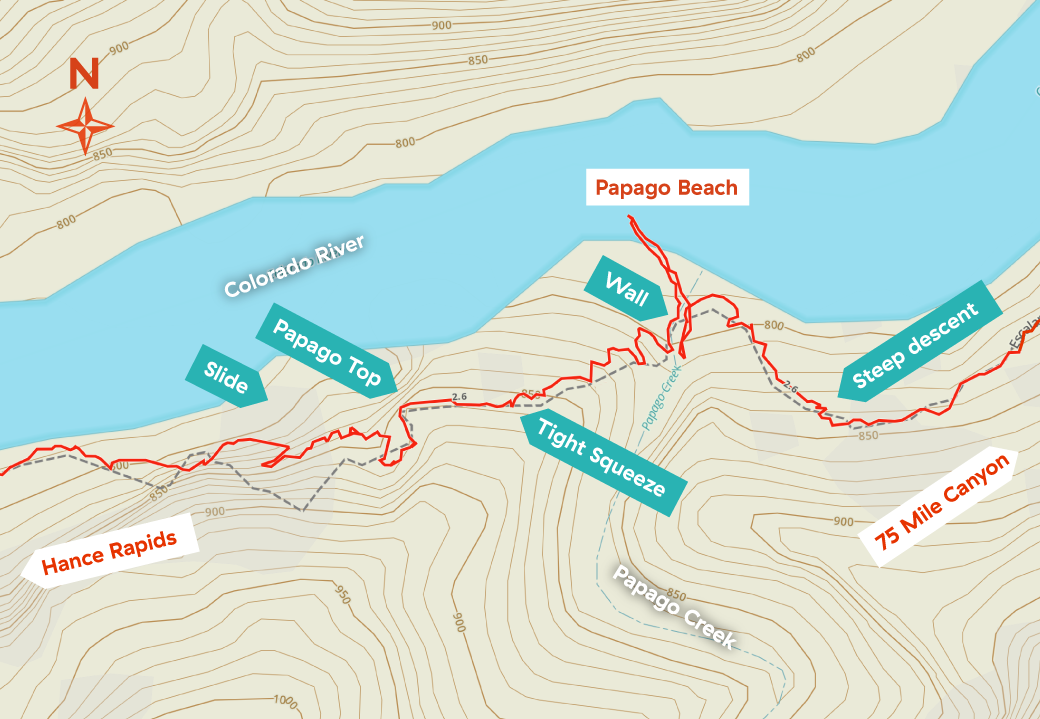
Escalante Route: Papago Wall and Slide. Note that the recorded trail (in red) differs from the trail drawn into the digital map (grey dashed line) in the Slide-section.
Before arriving at Papago Beach there is an abrupt descent from the higher trail above the Colorado River. Do not underestimate this descent – I found it almost as difficult as the Slide that came later.
Experienced mountain climbers will probably laugh at this Wall and Slide thing. But this blog is not meant for mountain climbers, but for hikers. As a hiker I enjoy walking long trails, and not climbing walls. And when I was preparing for the Escalante Route, this section of the hike worried me. Especially because it was very hard to find detailed information – and much of what I found was incomplete, partly mistaken or contradictory. So in this post I have compiled a guide based on all the information that I found and was confirmed in reality.
How much time does it take?
Depending on your abilities and physical condition the entire Wall and Slide will take about 30 tot 60 minutes. An avid mountaineer will probably rush through within 15 minutes, while someone with fear of heights and less training in difficult terrain might scramble for 2 hours. Remember this is not a race – I did it in 1 hour (including a short break) and enjoyed every minute of it.
Papago Wall Overview
When you hike the high trail above the Colorado River, coming from 75 Mile Canyon, you’ll get a good view of the Papago Wall. The entire route from the beach to the Papago Top (where the Slide begins) is clearly visible.
As you can see below, the actual ‘Wall’ is just a small part at the beginning, about 30 ft (10 m) high. From a distance this wall might look slick, but once you stand in front of it, you will see that it actually has a whole series of ledges that enable a relatively easy ascent to the top of the wall.
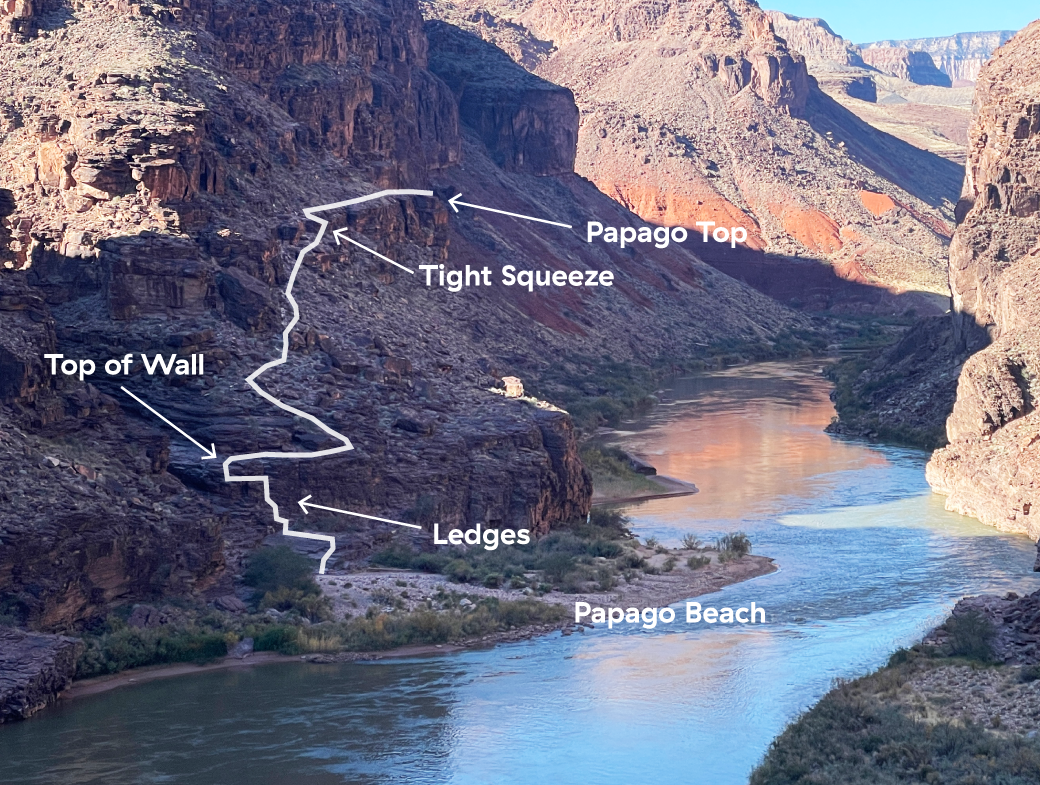
Overview of the Papago Wall ascent
Contrary to some hiker’s advice, I believe you do not need ropes to haul your pack to the top, as long as you take these precautions:
- Pack your (folded) hiking poles tightly in your backpack,
- make sure the heavy items in your pack are low and close to your body,
- loose weight by emptying water bottles, leaving half a liter – you’ll be at the river again soon.
I climbed the wall with about 30 pounds (14 kg) on my back without any problems.
Papago Ledges Ascent
From the beach, step onto the large dark rock slab and approach the wall on the left side. You will probably notice that the dark patina is worn off of the rock, leaving a brown-yellow trace of those who went before you.
For your orientation, look for an outcrop that looks like Kermit the Frog’s face (or maybe I just have too much imagination). This will be your guide on the way up. Just follow the ledges that actually resemble a stone staircase. After about 3 or 4 big steps up, you will be close to Kermit and you will see a narrow chimney above you. Although I have seen many hikers on video trying to push themselves up the chimney – the best way is to go to the left at this point (ignore cairns on top of the chimney).
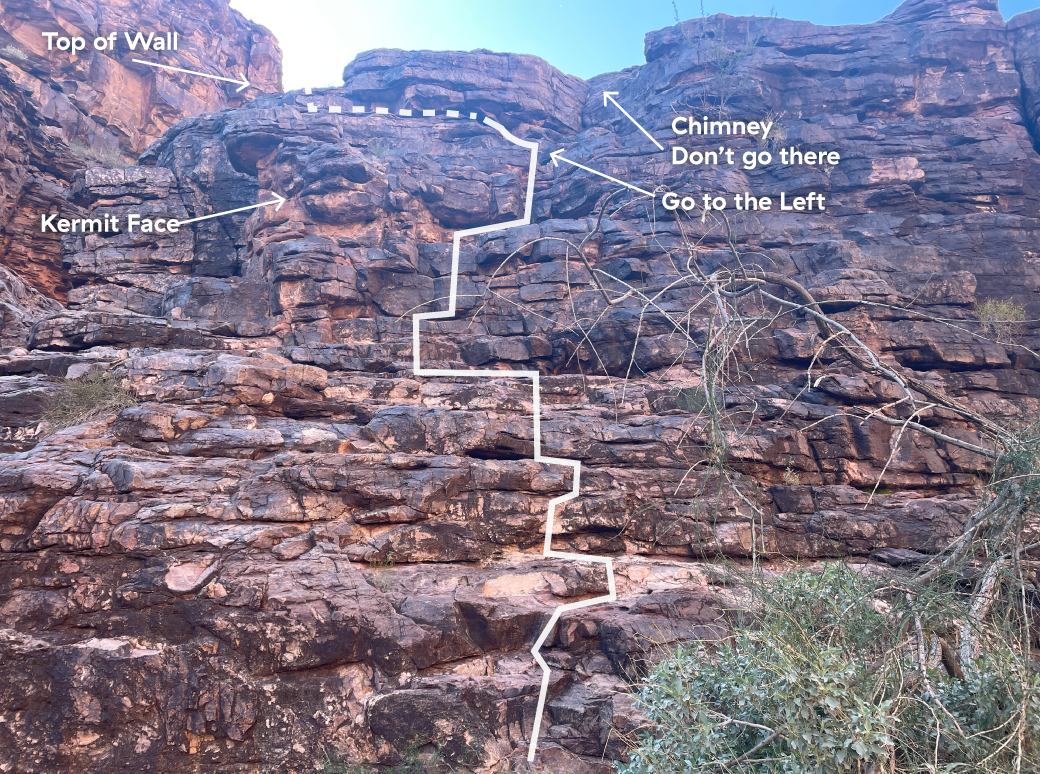
The Ledges Route on the Papago Wall
Take a good look to the left to find the ledges that will take you sideways and up to the wall top. Also look for cairns on the top to your left. Remember to go slowly. Even then you will probably be at the top of the wall within a few minutes.
Ascent to the Papago Top
Once at the top, carefully walk in downstream direction along the edge of the wall you just climbed. After a few yards, go left at the big black boulders. There will be many cairns showing the way. Just keep in mind that you have to go downstream and up to the ridge above you.
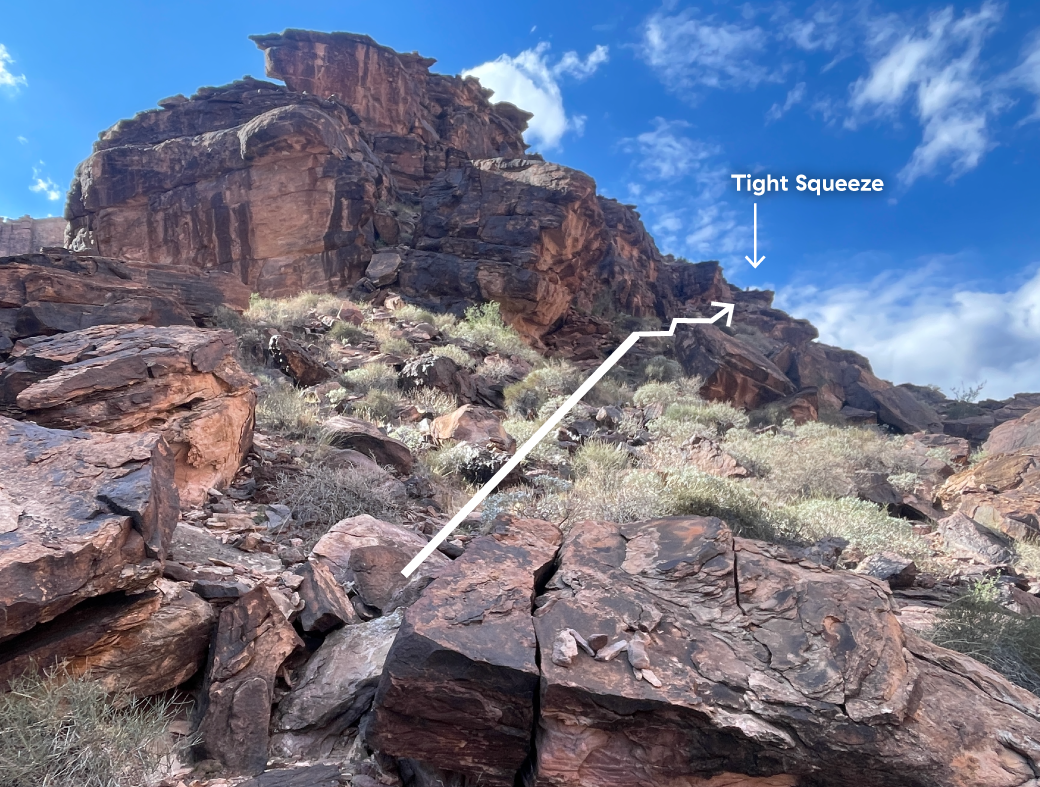
Follow cairns to the protruding cliff with the Tight Squeeze
The Tight Squeeze
The second climb at Papago is the scramble towards what is called the ‘Tight Squeeze’, a narrow opening between protruding rocks at the ridge, leading to a flat trail above it. There is actually a more or less visible trail all the way up, and many cairns will help as well. Just walk towards the ridge and keep close to the wall.
Soon you will reach the Squeeze on your left hand where you will have to slip through and clamber up (± 1 yard / 1 m.). The opening is so tight, that you will indeed have to squeeze yourself through. My backpack was about 20 inch (50 cm) wide, and using my hands and some force, I could just slip through. A very big person might have some difficulties here. In that case, take off your backpack, it’s not difficult to shove it up the ridge from below.
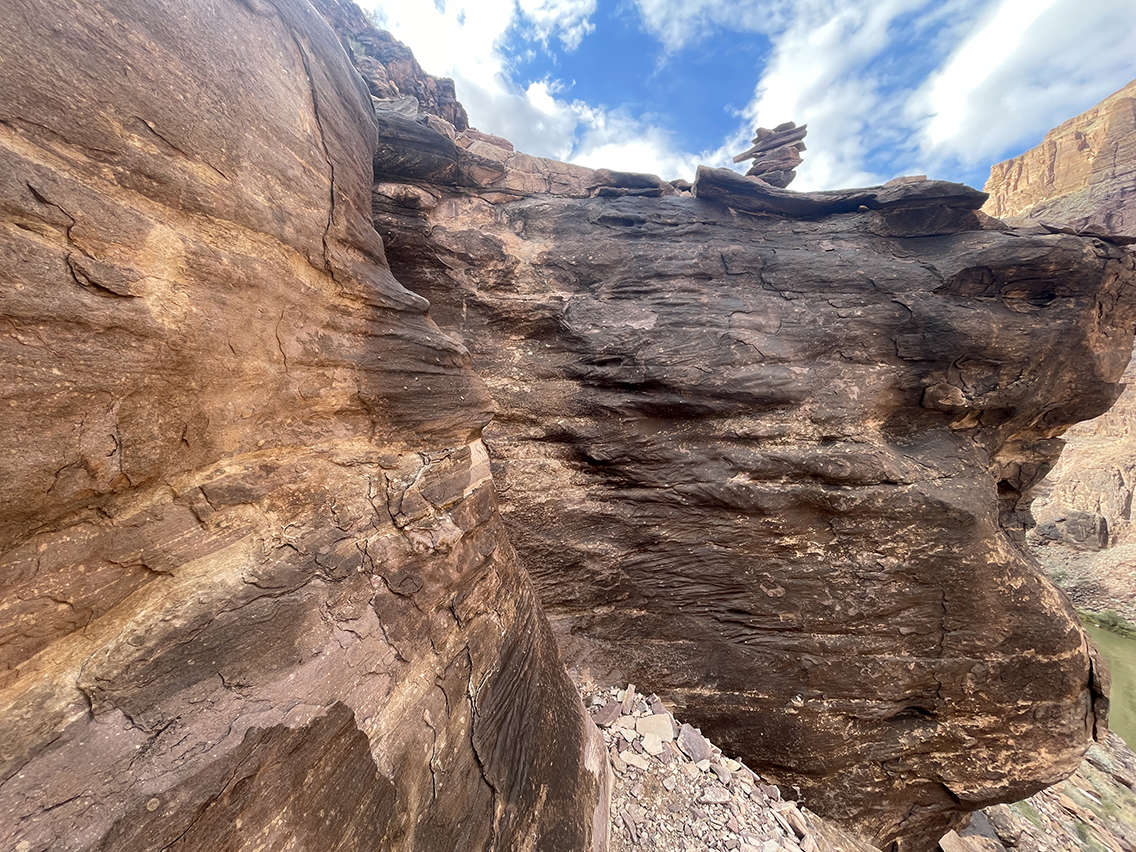
Entrance to the Tight Squeeze marked by a large cairn
Popping up from the Squeeze, you have arrived at a flat and straight trail that leads towards the Papago Top. The views from the ridge towards Red Canyon and Hance Rapids are amazing, but looking down is optional: this is a rather exposed section.
The Papago Slide
The Papago Top marks the start of the Papago Slide, also knows as the Papago Chute. From the top there are even more dramatic views of the Colorado River flowing towards Hance Rapids. The top is highly exposed: the cliff on the river side plunges vertically 230 ft (70 m) into the river. Before heading on, stand still and take some time to study the chaotic mass of scree and boulders before you. You will notice there is a visible trail on the middle part of the chute. In preparation I named various boulders and other distinctive features to make myself familiar with the route – see the picture below.
For your safety:
- For this section I would recommend using trekking poles.
- When hiking in a group: either stay very close or go one by one to avoid rockfall on the ones below you.
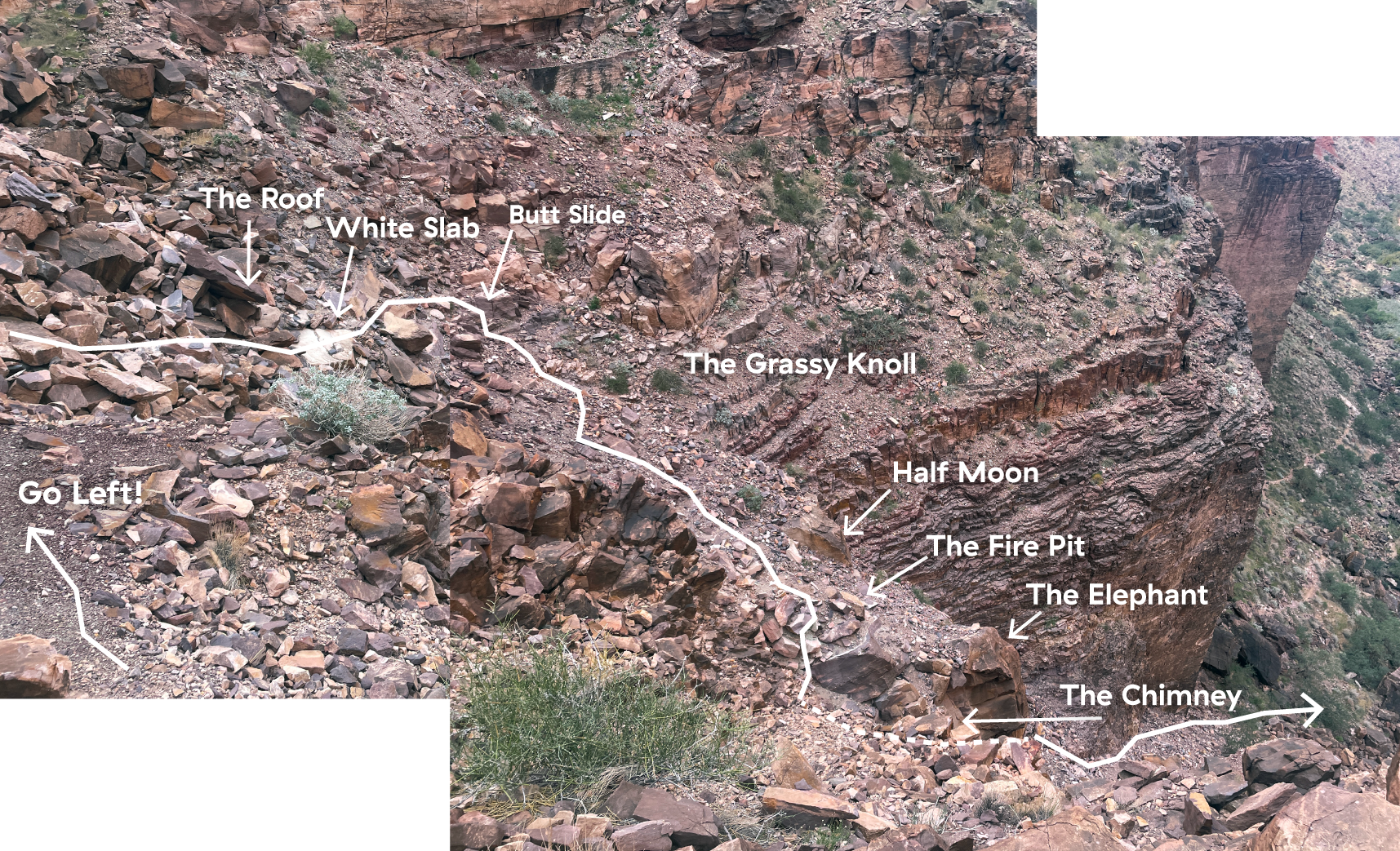
The safe route down the Papago Slide
The Grassy Knoll
The crucial thing at the Papago Slide is to cross the chute to the other side before descending. This means first going left. Make sure you do not go down into the chute on the right, directly near the Papago Top. Many have tried this, leaving a suggestion of a trail. But this is not the right way. Go left a few yards until you see The Roof and the White Slab on your right hand. Then go right and follow the rocks and slabs to the other side (not descending yet), until you see the Grassy Knoll close below you. Turn right and go down, probably sliding on your butt, towards the grass.
The Fire Pit
Now you’re on the ‘trail’ part of the slide. Descend on the loose gravel, towards the Half Moon rock, where you’ll bend to the right to the Fire Pit. At this point you will have to either scramble, slide or jump into the Chimney: the steep gravel shaft below the Elephant (this part is not visible on the photo, hidden behind the ravine’s edge).
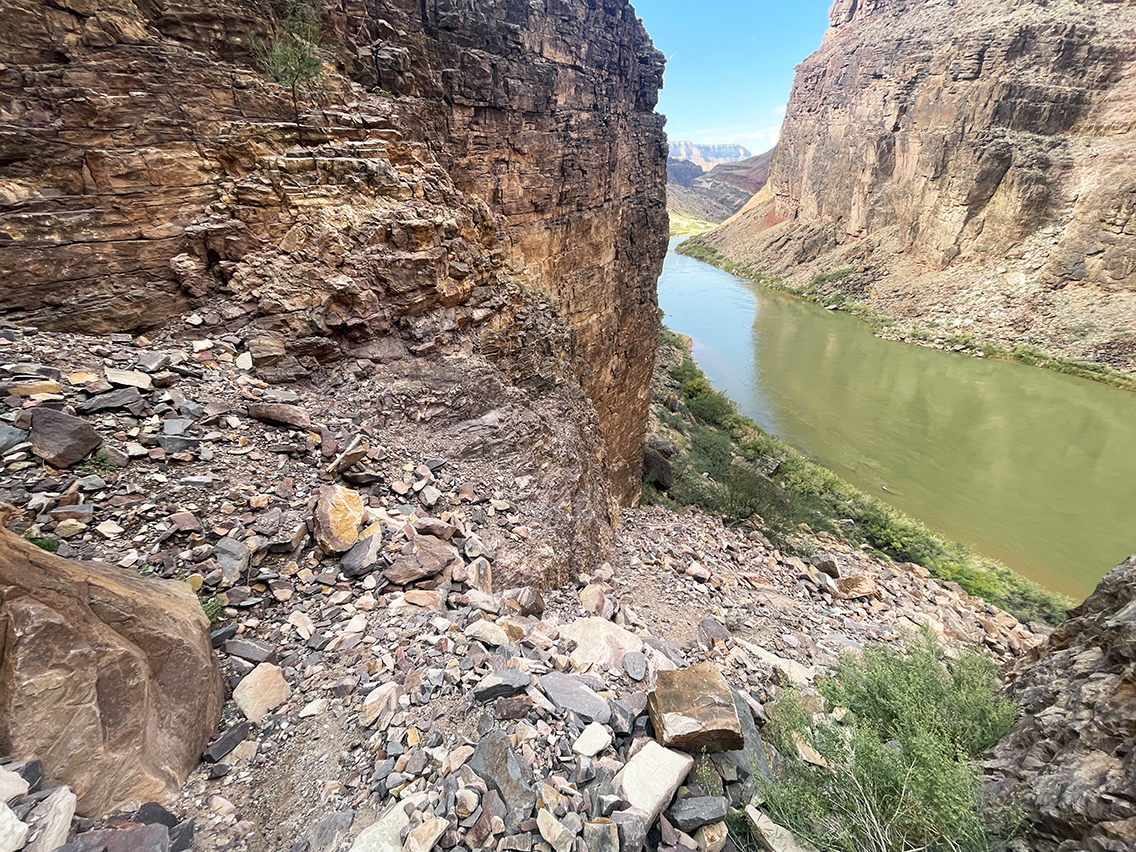
Almost there: below the Chimney at the end of Papago Slide
The Chimney
Once you’re down in the Chimney, you can use the side of the Elephant for handholds, which you will need because this shaft is extremely steep and consists of pure loose gravel. Trekking poles will also be helpful to negotiate this section. Slowly the route will get easier with every step. The view of the Colorado River will brighten your spirits as you approach the grassy riverside. Look for cairns to get close to the river (there is a higher trail visible, but the low trail is easier to find) and follow the rest of the Escalante Route on the easy and sandy trail to Hance Rapids.
If you have questions about this route, or if you have corrections – please leave a comment below.
> Read the complete trip report: Escalante Route, Grand Canyon

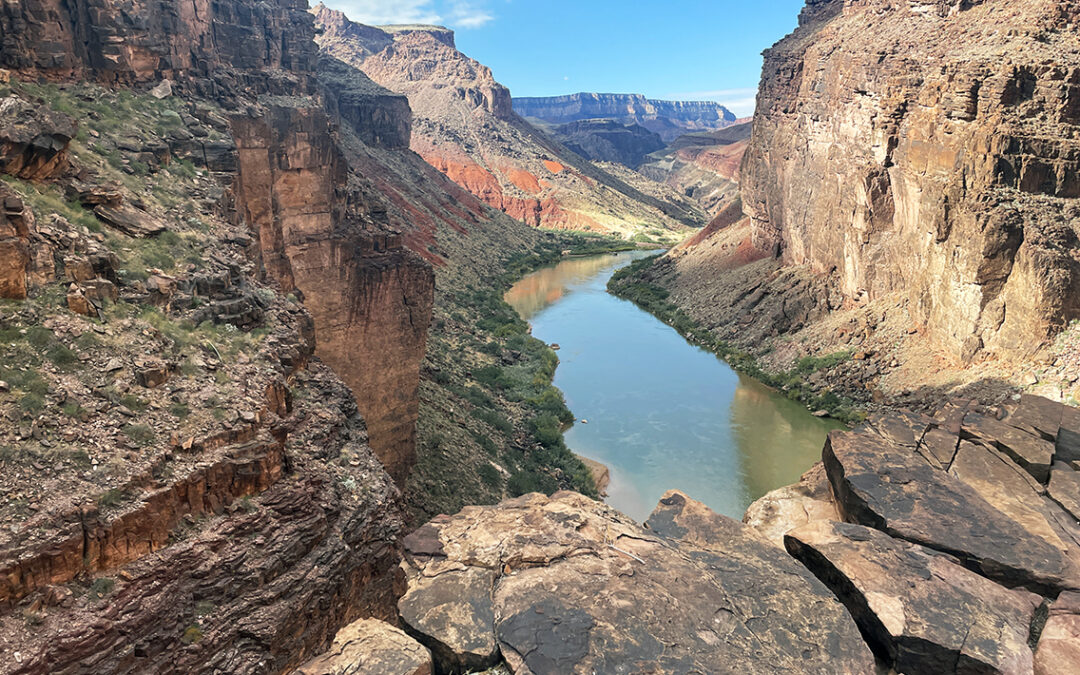
Hi Pieter. My wife and I just completed the route in 4 days, 3 nights. It was spectacular. Thank you for the guide to the wall and slide. The wall was quite easy. We passed our packs up as we climbed. The slide on the other hand was extremely risky, especially at the top as you traverse under the wall. There is absolutely nothing stable on the slide. I was a bit more comfortable than my wife, but I too was extremely uncomfortable with the risk. Lowering the packs with rope would have made movement on the slide a bit better as it was quite difficult with them. This is our third backcountry trip in the canyon including the Boucher trail for reference. Unfortunately, I will never do this wonderful route again because of the risk of the slide. Sad because this is a magnificent route otherwise.
Hello Chris, thanks for your comment. I’m happy to hear that you found my guide helpful and that you came back safely.
Also thanks for the update on the present condition of the Slide. Apparently it has deteriorated the past 2 years. I will put up an update on this post as a warning.
Any thoughts or information on going through this area in the upstream direction please?
Hello George,
I think there are 2 disadvantages for going upstream:
1. The Papago Slide and Wall are more difficult to ascend than to descend.
2. The Tanner trail is very long with no water source, and very difficult to hike up in one day.
I would definitely recommend starting at Tanner and going downstream.
What is the reason you would consider upstream?
i am heading out there at the end of april- thanks for the details! i’ll check back in when i am back!
Hello Ren, I’ll be at the Canyon as well, April 26-28. I’ll be hiking the Hermit Trail with my 4 children.
Hi Paul, a friend and I plan to do this route 02/03/2025. Thank you for the great information. Hopefully we’ll get more information if someone goes before that date. If I remember to do it I’ll send an update when we get out around the 9th. Doing the Tanner Trail to Bright Angel Trail.
Happy Holidays, Pete Murphy
Hi there Peter. Did you end up doing the Escalante route on 2/3? Curious of your experience at the slide. Hope you had a great trip!
Does anyone know how the slide has changed since the October 2024 rockslide? I just got a notice about the instability of the slide from the Park Service because I have a March 2025 permit for the Escalante Route. I went through it before and found that it was much easier than pre-trip anxiety made it. Now I’m growing anxious again.
Hello Paul, from what I’ve read online (on Reddit mostly), the basics are the same: first make the traverse to the opposite side, then down towards the chimney.
A recent photo (via reddit) shows that the ‘white slab’ on the traverse is still there, the ‘trail’ towards the ‘firepit’ is the same, only with some more loose gravel. The ‘half moon’ rock is partly covered.
From what I understand the Slide is now just a bit more difficult, but still doable.
Beware of falling rocks at all times: go one by one with enough distance, or go all together when descending in a group.
Thank you. We’ll proceed with a little more caution, but without an excess of worry. Since the park service emailed everyone with an Escalante Route permit, I’m sure there will be more folks heading to your page. It’s a great resource, and I appreciate it.
Thanks, and have a good trip! Please let me know your experiences at the slide.
I went down(river) through the slide solo on 12/29 and this guide is still solid. I got to the Chimney with no issue by generally following the white line and the landmarks were mostly visible.
My only trouble was that I didn’t continue to follow the white line beyond the chimney which would hug the rock wall on the left (South) side. I followed social tracks/erosion to the right wall and that was definitely NOT correct. I surfed down the talus on a combination of feet and rear.
Thanks Tyler for your comment and update!
Glad you made it down safely.
I did this a long time ago and would have loved to have this description, we found the wall to be a paper tiger, but we didn’t have your instructions and one of our girls almost freaked out on the slide. After we got the girl calmed down we went straight down from your “go left” marker which we obviously survived. The last bit going down the chimney was just sort of a controlled slide. For anyone who hasn’t done this. This description of how to do the slide is excellent. For hikers the slide is fairly daunting.
Thanks Clyde for your comment.
Thank you so much for the detailed descriptions of this trail. I am doing the this October 11-14th with the TSX challenge and I was so worried about the this part of the hike. After reading this I feel more confident!! Now I need to get over the fear of the snakes and scorpions. LOL
Hello Christine,
thanks for your comment. I hope you have a great time! As long as you don’t reach underneath rocks and shrubs you will probably not encounter any snake or scorpion.
Loved reading through this! Reminded me of my Escalante Route trip back in October 2023. I recognize that white rock on the slide. One of our waypoints too!
Nice to hear that, thanks.
This guide was an absolute lifesaver, thank you! I also found the wall itself to be relatively trivial, but I think it might be worth adding that as you come around the corner to the top of the Slide don’t worry that it initially looks like a 300 foot plunge to the river below because once you get oriented you will be able to see the route. Thank you so much for this level of detail.
Hello Micah, thanks for the kind words and your addition!
Pieter, I’ll throw another accolade your way as well. This is great information. I leave with a party of 3 others this coming Monday for our 5 day 4 night hike of the Escalante Route and am so excited. Your report has increased my chances of a success. As to the wall and Slide, I am a climber and doubt that would bother me too much. Some of the trail exposure along the route has gained more of my attention than those two obstacles. Thanks again. Tom
Hello Tom, thank you so much. It’s exciting to hear you’ll be on the trail in a few days!
Since you’re a climber, the Wall and Slide will indeed pose no difficulties for you. The exposure along the route is not extreme. Just take care a certain parts, especially climbing out of the canyon towards the Horseshoe Mesa. Have fun and enjoy the hike!
Thank you so much Pieter!! Some other reviews of the Escalante trail got my hands sweaty for this section but your detailed description & photos made me breeze right through. An amazing resource to get some confidence to go out there and do it.
For anyone doing the route: bring these screenshots with you on the trail 🙂
Thanks Lisa, I’m happy to hear that my post was helpful. Great that you’ve made it to this amazing place.
Pieter- You are absolutely right, detailed information on the Papago wall and slide is hard to find but then I found your post! Thank you for the well written description of both the wall and the slide. My adult daughter and I are backpacking the Escalante Route in mid-October 2023. We’re both very excited about the trip.
Hello Tom, thanks, I’m really happy my blog is helpful. Must be great to go on this hike with your daughter, have fun and enjoy the canyon!
Best description I’ve seen to date. Thank you!
Thanks!
Pieter, you have the best description of Papago wall/slide! More I looked at videos more intimidating it looked. Escalante route it’s been on my list for a while after I did rim to rim, Boucher and Hermit trails.
You need to come back and do JMT! I live in CA so logistics for my SOBO and NOBO were very easy. This year will be very challenging due to big snow.
Happy trails!
Elena
Hello Elena, Thanks! I was intimidated as well, but in the end I think the Escalante Route was not too difficult. So I hope this will help you.
I really hope to come back to California and hike the JMT one day.